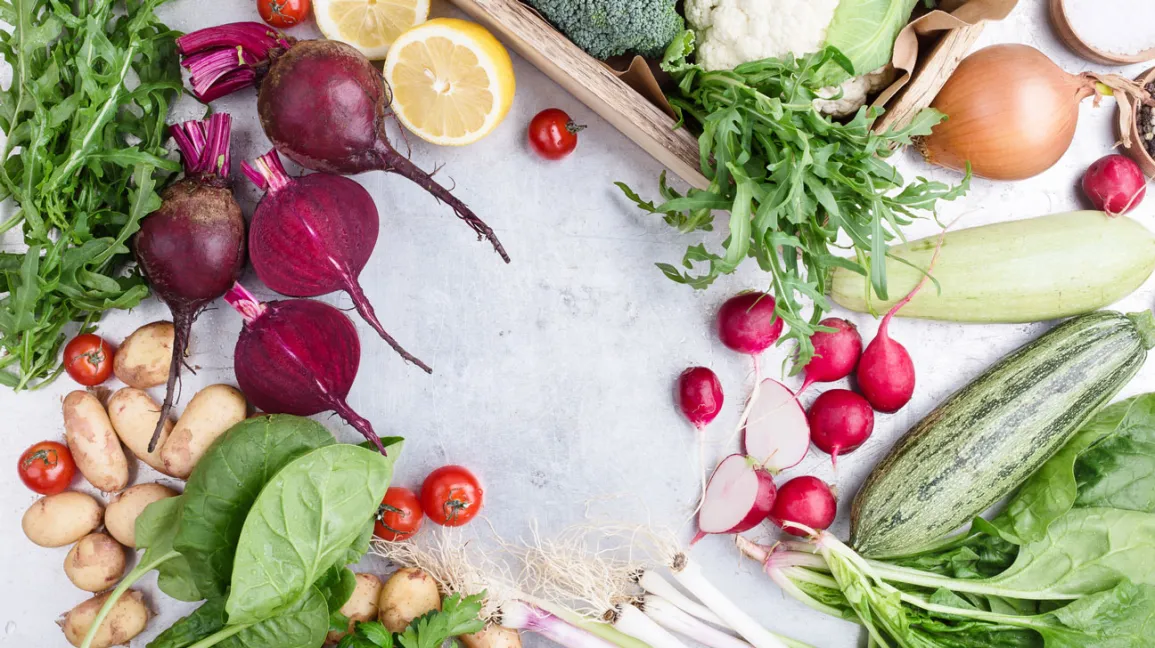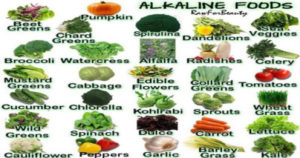A LOOK AT AN ALKALINE DIET

Please note our content is intended solely for informational purposes and should not be used in place of official medical advice.
The alkaline diet is also known as the acid-alkaline diet or alkaline ash diet. Its premise is that your diet can alter the pH value — the measurement of acidity or alkalinity — of your body. Your metabolism — the conversion of food into energy — is sometimes compared to fire. Both involve a chemical reaction that breaks down a solid mass. However, the chemical reactions in your body happen in a slow and controlled manner. When things burn, an ash residue is left behind. Similarly, the foods you eat leave an “ash” residue known as metabolic waste. This metabolic waste can be alkaline, neutral, or acidic. Proponents of this diet claim that metabolic waste can directly affect your body’s acidity. In other words, if you eat foods that leave acidic ash, it makes your blood more acidic. If you eat foods that leave alkaline ash, it makes your blood more alkaline. According to the acid-ash hypothesis, acidic ash is thought to make you vulnerable to illness and disease, whereas alkaline ash is considered protective. By choosing more alkaline foods, you should be able to “alkalize” your body and improve your health. Food components that leave an acidic ash include protein, phosphate, and sulfur, while alkaline components include calcium, magnesium, and potassium (1Trusted Source, 2Trusted Source). Certain food groups are considered acidic, alkaline, or neutral:
- Acidic: meat, poultry, fish, dairy, eggs, grains, alcohol
- Neutral: natural fats, starches, and sugars
- Alkaline: fruits, nuts, legumes, and vegetables

Regular pH levels in your body When discussing the alkaline diet, it’s important to understand pH. Put simply, pH is a measurement of how acidic or alkaline something is. The pH value ranges from 0–14:
- Acidic: 0.0–6.9
- Neutral: 7.0
- Alkaline (or basic): 7.1–14.0
Many proponents of this diet suggest that people monitor the pH of their urine to ensure that it is alkaline (over 7) and not acidic (below 7). However, it’s important to note that pH varies greatly within your body. While some parts are acidic, others are alkaline — there is no set level. Your stomach is loaded with hydrochloric acid, giving it a pH of 2–3.5, which is highly acidic. This acidity is necessary to break down food. On the other hand, human blood is always slightly alkaline, with a pH of 7.36–7.44 (3Trusted Source). When your blood pH falls out of the normal range, it can be fatal if left untreated (4Trusted Source). However, this only happens during certain disease states, such as ketoacidosis caused by diabetes, starvation, or alcohol intake (5Trusted Source, 6Trusted Source, 7Trusted Source). The alkaline diet is quite healthy, encouraging a high intake of fruits, vegetables, and healthy plant foods while restricting processed junk foods. A food with a pH below 4.6 is high in acid. This includes many citrus fruits, plums, grapes, pomegranates, and several other fruits. Tomatoes, which are technically a fruit, are also acidic. Defining acidity The pH value tells you if something is an acid, a base, or neutral.
- A pH of 0 indicates a high level of acidity.
- A pH of 7 is neutral.
- A pH of 14 is the most basic, or alkaline.
For example, battery acid is extremely acidic at 0, while liquid drain cleaner is very alkaline at 14. Pure distilled water is in the middle at 7. It’s neither acidic nor alkaline. Just like different substances, different parts of the human body have different pH levels. Your ideal blood pH is between 7.35 and 7.45, which is slightly alkaline. The stomach is typically at a pH of 3.5, which helps food break down properly.
What is pH?
When discussing acidic versus alkalizing foods, it’s important to understand the concept of pH. Put simply, pH is a rating of how acidic or alkaline a solution is on a scale from 0–14. A pH of 7 is considered neutral. Any pH value below 7 is considered acidic, and any pH value over 7 is considered alkaline (1, 2). On the pH scale, the difference between adjacent numbers represents a tenfold difference in acidity. For instance, a pH of 5 is 10 times more acidic than a pH of 6 and 100 times more acidic than a pH of 7. Because they contain a high amount of citric acid, lemons have an acidic pH. Lemon juice has a pH between 2 and 3, which means it’s 10,000–100,000 times more acidic than water (1, 2, 3). High-acid food and drink If you suspect you have problems with acidity, you can make changes to your diet to help improve symptoms. Foods that are considered acidic must have a pH level of 4.6 or lower. Foods that tend to cause more acidity in the body and that you may need to limit or avoid include:
- grains
- sugar
- certain dairy products
- fish
- processed foods
- fresh meats and processed meats and turkey
- sodas and other sweetened beverages
- high-protein foods and supplements
Fruits and fruit juices high in acid Here’s a list of fruits and their pH from Clemson University. They are listed from most acidic to least:
- lemon juice (pH: 2.00–2.60)
- limes (pH: 2.00–2.80)
- blue plums (pH: 2.80–3.40)
- grapes (pH: 2.90–3.82)
- pomegranates (pH: 2.93–3.20)
- grapefruits (pH: 3.00–3.75)
- blueberries (pH: 3.12–3.33)
- pineapples (pH: 3.20–4.00)
- apples (pH: 3.30–4.00)
- peaches (pH: 3.30–4.05)
- oranges (pH: 3.69–4.34)
- tomatoes (pH: 4.30–4.90)
Generally, citrus fruits have a low pH, meaning they are acidic. Citrus and other acidic foods may contribute to symptoms in those with upper gastrointestinal issues like an ulcer or reflux. It’s important to remember that fruit juices are acidic, too. Because of this, you should use a straw when drinking fruit juices. This keeps the fruit juice from coming in direct contact with your teeth. If fruit doesn’t aggravate upper digestive symptoms, they are a healthy food to eat daily and have been shown to reduce chronic disease risk. Despite their initial acidity, most fruits are alkalizing. Fresh vegetables Vegetables, especially fresh vegetables, are generally not considered acidic. Here’s a list of vegetables and their pH levels:
- sauerkraut (pH: 3.30–3.60)
- cabbage (pH: 5.20–6.80)
- beets (pH: 5.30–6.60)
- corn (pH: 5.90–7.50)
- broccoli (pH: 6.30-6.85)
- collard greens (pH: 6.50–7.50)
Low-acid foods When it comes to the benefits of a more alkaline diet, research published in the Journal of Environmental and Public HealthTrusted Source says that no conclusive evidence suggests it improves bone health. However, it may help limit muscle loss, strengthen memory and alertness, and help you live longer. Some alkalizing (or neutral) foods and beverages you can incorporate into your diet include:
- soy, such as miso, soy beans, tofu, and tempeh
- unsweetened yogurt and milk
- most fresh vegetables, including potatoes
- most fruits
- herbs and spices, excluding salt, mustard, and nutmeg
- beans and lentils
- some whole grains, such as millet, quinoa, and amaranth
- herbal teas
- fats like olive oil, avocados, nuts, and seeds
Effects of eating too many acid-producing foods A diet that includes too many acid-producing foods, such as protein or sugar, can cause acidity in your urine as well as other negative health effects. This may cause a type of kidney stone called uric acid stones to form. It’s been speculated that too much acidity can also cause bone and muscle deterioration. This is because bones contain calcium, which your body uses to restore your blood’s pH balance when it becomes too acidic. Some evidence suggests that phosphoric acid, commonly found in darker sodas, is linked to lower bone density, especially when it replaces milk, a calcium- and protein-rich beverage. Too much acidity can also increase your risk for cancer, liver problems, and heart disease. Some foods and beverages produce less acid than sodas or protein, but they still don’t provide the major alkalizing effect of most fruits and vegetables. Experts don’t always agree on the exact food lists. Aim to limit these foods since they may be affecting your acid-base balance or affecting your health in negative ways:
- corn oil
- sweeteners, such as sugar, molasses, maple syrup, processed honey, and aspartame
- salt
- condiments, such as mayonnaise, soy sauce, and vinegar
- hard and processed cheeses
- grains, such as corn, rice, and wheat
- coffee
Takeaway
The alkaline diet is a healthy alternative that may work due more to the emphasis on consuming plants and limiting processed foods than to changing the body’s pH. Eating more fruits and vegetables, along with curbing your refined carbohydrate, sugar, and dairy intake, may or may not help balance pH levels within your body. Either way, a plant-heavy diet with reduced refined sugar intake has many health benefits and may reduce daily issues and lower the possibility of certain long-term health risks.


